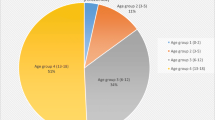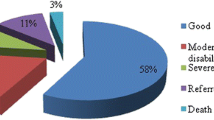Abstract
Objective
This study was undertaken to assess the clinical and radiological characteristics of children with traumatic extradural hematoma (TEDH), and factors affecting the initial neurological status and outcome.
Methods
Medical records of 269 consecutive children with TEDH from 2005 to 2012 were retrospectively reviewed, factors affecting the initial neurological status and outcomes were explored using univariate and multivariate analysis.
Results
There were 166 boys and 103 girls (average age: 7.0 years). Fall from a height (59 %) was the most common mechanism of head injury. With increasing age, an increase of motor-vehicle accident and assault was noted. Among the children 85.5 % experienced a Glasgow Coma Scale (GCS) of 13–15, 9.7 % with GCS 9–12, and 4.8 % with GCS 3–8. The main clinical manifestations were headache, vomiting and nausea, and conscious disturbance. The main locations were the temporal, temporoparietal, and frontal regions. The 97.4 % saw a favorable outcome, whereas 2.6 % had a poor outcome (overall mortality: 1.1 %).
Conclusion
Many factors influenced the prognosis; the most important factors affecting prognosis were the initial neurological condition and secondary brain edema, while the initial neurological status were associated with pupillary abnormality, clinical progression, the number and volume of TEDH, and midline shift. Although the outcome was excellent in most cases, early diagnosis and surgical evacuation before irreversible brain damage was important to lower mortality for those massive TEDHs.

Similar content being viewed by others
References
Balmer B, Boltshauser E, Altermatt S, Gobet R (2006) Conservative management of significant epidural haematomas in children. Childs Nerv Syst 22(4):363–367
Ben Abraham R, Lahat E, Sheinman G, Feldman Z, Barzilai A, Harel R, Barzilay Z, Paret G (2000) Metabolic and clinical markers of prognosis in the era of CT imaging in children with acute epidural hematomas. Pediatr Neurosurg 33(2):70–75
Beni-Adani L, Flores I, Spektor S, Umansky F, Constantini S (1999) Epidural hematoma in infants: a different entity. J Trauma 46(2):306–311
Bozbuğa M, Izgi N, Polat G, Gürel I (1999) Posterior fossa epidural hematomas: observations on a series of 73 cases. Neurosurg Rev 22(1):34–40
Browne GJ, Lam LT (2002) Isolated extradural hematoma in children presenting to an emergency department in Australia. Pediatr Emerg Care 18(2):86–90
Bullock MR, Chesnut R, Ghajar J, Gordon D, Hartl R, Newell DW, Servadei F, Walters BC, Wilberger JE (2006) Surgical management of acute epidural hematomas. Neurosurgery 58 (3 Suppl):S7–15
Bullock R, Smith RM, van Dellen JR (1985) Nonoperative management of extradural hematoma. Neurosurgery 16(5):602–606
Chen TY, Wong CW, Chang CN, Lui TN, Cheng WC, Tsai MD, Lin TK (1993) The expectant treatment of “asymptomatic” supratentorial epidural hematomas. Neurosurgery 32(2):176–179, discussion 179
Ciurea AV, Kapsalaki EZ, Coman TC, Roberts JL, Robinson JS 3rd, Tascu A, Brehar F, Fountas KN (2007) Supratentorial epidural hematoma of traumatic etiology in infants. Childs Nerv Syst 23(3):335–341
Dubey A, Pillai SV, Kolluri SV (2004) Does volume of extradural hematoma influence management strategy and outcome. Neurol India 52(4):443–445
Erşahin Y, Mutluer S, Güzelbag E (1993) Extradural hematoma: analysis of 146 cases. Childs Nerv Syst 9(2):96–99
Flannery AM (2009) Cautions in the conservative management of epidural hematomas. Pediatr Neurosurg 45(3):185
Gerlach R, Dittrich S, Schneider W, Ackermann H, Seifert V, Kieslich M (2009) Traumatic epidural hematomas in children and adolescents: outcome analysis in 39 consecutive unselected cases. Pediatr Emerg Care 25(3):164–169
Greenes DS, Schutzman SA (1999) Clinical indicators of intracranial injury in head-injured infants. Pediatrics 104(4 Pt 1):861–867
Hahn YS, Chyung C, Barthel MJ, Bailes J, Flannery AM, McLone DG (1988) Head injuries in children under 36 months of age. Demography and outcome. Childs Nerv Syst 4(1):34–40
Hanci M, Uzan M, Kuday C, Cetin A, Akar SZ, Canbaz B, Erdincler P, Akcura S (1994) Epidural hematomas in infancy and childhood: report of 54 cases. Turk Neurosurg 4:73–76
Herrera EJ, Viano JC, Aznar IL, Suarez JC (2000) Postraumatic intracranial hematomas in infancy. A 16-year experience. Childs Nerv Syst 16(9):585–589
Irie F, Le Brocque R, Kenardy J, Bellamy N, Tetsworth K, Pollard C (2011) Epidemiology of traumatic epidural hematoma in young age. J Trauma 71(4):847–853
Jamjoom AB (1997) The difference in the outcome of surgery for traumatic extradural hematoma between patients who are admitted directly to the neurosurgical unit and those referred from another hospital. Neurosurg Rev 20(4):227–230
Jamjoom A, Cummins B, Jamjoom ZA (1994) Clinical characteristics of traumatic extradural hematoma: a comparison between children and adults. Neurosurg Rev 17(4):277–281
Jamous MA, Abdel Aziz H, Al Kaisy F, Eloqayli H, Azab M, Al-Jarrah M (2009) Conservative management of acute epidural hematoma in a pediatric age group. Pediatr Neurosurg 45(3):181–184
Koç RK, Paşaoğlu A, Menkü A, Oktem S, Meral M (1998) Extradural hematoma of the posterior cranial fossa. Neurosurg Rev 21(1):52–57
Kuday C, Uzan M, Hanci M (1994) Statistical analysis of the factors affecting the outcome of extradural haematomas: 115 cases. Acta Neurochir (Wien) 131(3–4):203–206
Paiva WS, Andrade AF, Mathias Júnior L, Guirado VM, Amorim RL, Magrini NN, Teixeira MJ (2010) Management of supratentorial epidural hematoma in children: report on 49 patients. Arq Neuropsiquiatr 68(6):888–892
Paşaoğlu A, Orhon C, Koç K, Selçuklu A, Akdemir H, Uzunoğlu H (1990) Traumatic extradural haematomas in pediatric age group. Acta Neurochir (Wien) 106(3–4):136–139
Poon WS, Rehman SU, Poon CY, Li AK (1992) Traumatic extradural hematoma of delayed onset is not a rarity. Neurosurgery 30(5):681–686
Rivas JJ, Lobato RD, Sarabia R, Cordobés F, Cabrera A, Gomez P (1988) Extradural hematoma: analysis of factors influencing the courses of 161 patients. Neurosurgery 23(1):44–51
Sengupta RP, Hankinson J (1972) Extradural haemorrhage—a hazard of ventricular drainage. J Neurol Neurosurg Psychiatry 35(3):297–303
Conflict of interest
None
Author information
Authors and Affiliations
Corresponding author
Rights and permissions
About this article
Cite this article
Zhong, W., Sima, X., Huang, S. et al. Traumatic extradural hematoma in childhood. Childs Nerv Syst 29, 635–641 (2013). https://doi.org/10.1007/s00381-012-1971-x
Received:
Accepted:
Published:
Issue Date:
DOI: https://doi.org/10.1007/s00381-012-1971-x




